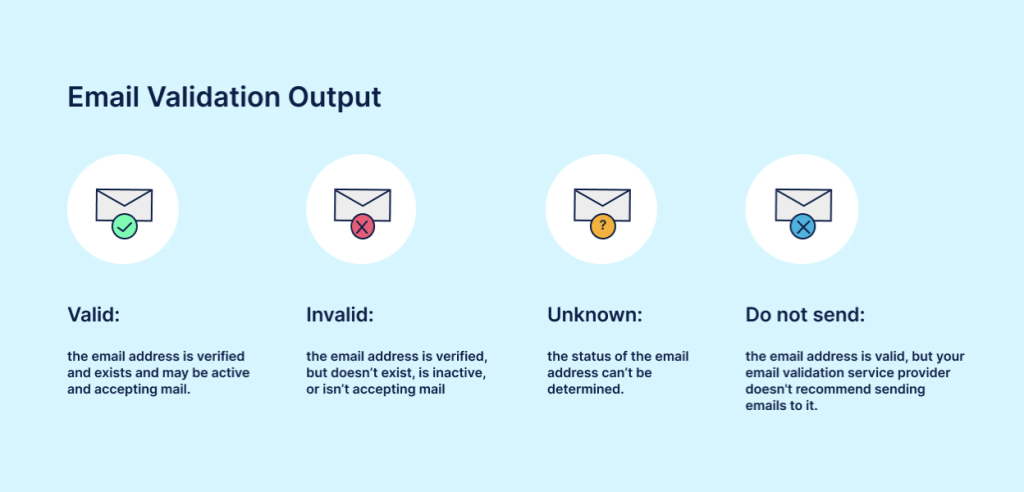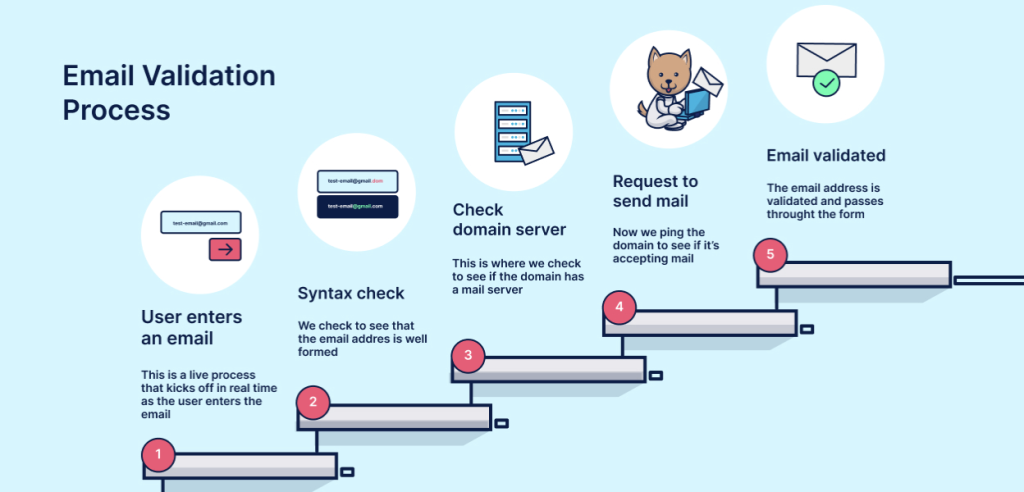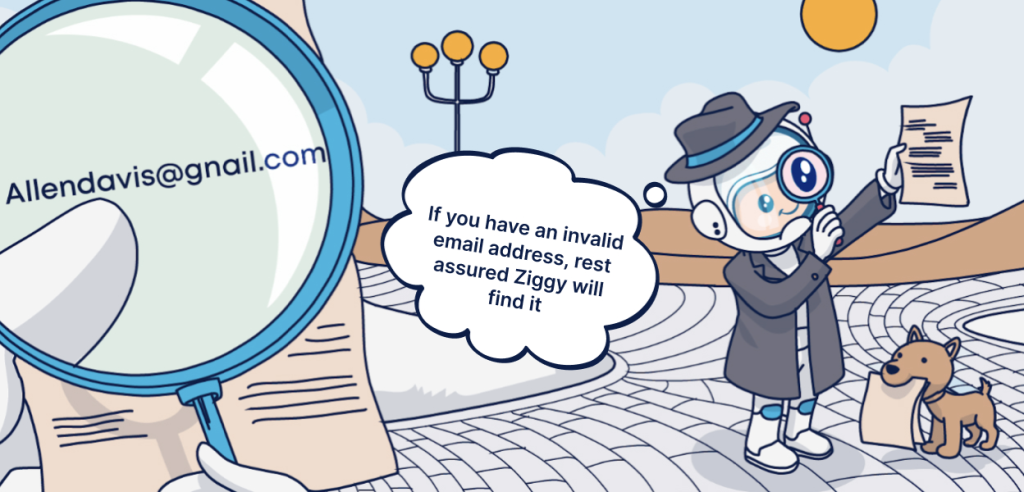Post written by Melissa Pekel and Haim Pekel
In 1825, the United States Postal Service established the first dead letter office to investigate and attempt to deliver lost mail.
Like snail mail, emails can go missing and undelivered. Though there’s no such thing as a virtual dead letter office, email validation tools can ensure your emails get to your intended recipients.
The concept of email might seem almost as old as snail mail itself, but email marketing is still an effective tool to reach your audience. In fact, 44% of customers consider general email the most significant influence on their online purchase decision, making email one of the top channels to grow your business. But to take advantage of email marketing, your emails must arrive at their intended destinations.
Fortunately, you don’t need to rely on slow and antiquated systems — like dead letter offices — to fix deliverability issues. By using email validation, you can get your emails to your intended recipients while discarding inaccurate, invalid, and toxic addresses.
What is email validation?
When you incorrectly address a piece of snail mail or send a letter to a person or place that doesn’t exist, it might end up in a dead letter office. It may even end up being returned to you.
That’s not the case with email. Failing to maintain proper email hygiene negatively impacts your sender reputation, a measurement used by ISPs to assess how well you adhere to their standards and regulations.
Effective email marketing requires capturing email addresses through a variety of sources. But even if you adhere to best practices, you run the risk of collecting incorrect, invalid, and fake email addresses. In some cases, your subscriber list might even include one or more spam traps.
Email validation analyzes your mailing lists to identify these dangerous email addresses, helping to avoid low engagement rates, high bounce rates, and spam complaints, in addition to spam traps and honeypots — all factors contributing to a negative sender reputation and low email deliverability.
During the validation process, the software checks each email address across a database and then assigns a status to each address in your mailing list:
- Valid: the email address is verified and exists and may be active and accepting mail.
- Invalid: the email address is verified, but doesn’t exist, is inactive, or isn’t accepting mail
- Unknown: the status of the email address can’t be determined.
- Do not send: the email address is valid, but your email validation service provider doesn’t recommend sending emails to it.
Credit: Ongage
Then, you can be certain you’re sending emails only to valid addresses that won’t jeopardize your email operation.
How are emails validated?
Credit: Ongage
- Syntax validation or regex validation: analyzes an email address to determine if it’s formatted correctly and if required or prohibited elements are present.
- Typo check: screens input text to identify and suggest corrections to common typos, such as @gnail.com or @domain..com.
- Bot check: flags email addresses that may be bot-generated, typically using gibberish in place of common human conventions (such as a name, sports team, or another legitimate word).
- Problematic domains: restricts or flags unwanted and dangerous domains, such as temporary mailbox providers, potential spam traps, and other suspect domains.
- Domain check: confirms that an inputted domain exists and is operational.
- MX records check: determines if any mail exchange (MX) servers are associated with a domain, which means it can receive emails.
- SMTP server check: tests the SMTP server revealed by the MX check to determine if the server is operational.
- SMTP mailbox check: verifies if a given email address exists on an SMTP server (though results can be tarnished if a server is set to “accept all”).
- Catch-all policy identification: determines if an SMTP server has an “accept-all” protocol in place that prevents you from receiving precise details about a given email address.
In most situations, your email validation tool will use a combination of these methods. This ensures you maintain proper email hygiene and protect your sender reputation.
How to validate new email leads
Credit: Ongage
New email leads aren’t always legitimate. A new subscriber may have incorrectly entered their email address, or you may have inadvertently added a spam trap or honeypot to your list — especially if you bought a mailing list (protip: never ever buy an email list).
You can use email validation to sift through the email addresses of any new subscribers to protect your sender reputation and email marketing ROI. Better yet, do that before adding them to your mailing list.
You can (and should) validate new email leads at two crucial times:
- When a lead converts into a new subscriber. And
- Immediately after a lead signs up on your mailing list.
It’s possible to do so in real-time or after they submit the sign-up form.
Real-time email validation methods
Real-time email validation takes place at the same time a new contact subscribes to your mailing list. By validating emails in real-time, you can reject problematic leads from the get-go to avoid spam traps, honeypots, and other unwanted addresses from compromising your email hygiene.
You can accomplish this by implementing an email validation tool’s API into your signup forms, account registration processes, and other lead magnets. Real-time email validation tools check the information a subscriber inputs in — you guessed it — real time, giving them the opportunity to correct any errors while keeping your mailing list clean of inaccurate and unwanted data.
This has the added bonus of improving the customer experience too. If a new subscriber is eager to receive a promotional email, signup, or other communication from your company, real-time validation improves the likelihood it’ll be delivered — and to the correct address.
Post-sign-up email validation methods
Email validation doesn’t end after a successful signup. To be on the safe side, you can require a double opt-in from new subscribers.
This is accomplished by sending a transactional email that asks a subscriber to confirm their decision to receive your emails. Without this confirmation, they’re not added to your list.
Requiring a double opt-in isn’t mandatory per any email regulator, but it helps keep your email list clean and protect against harmful agents.
How to validate current and old email leads
As postal workers did with stacks of old, yellowing envelopes, you can use email validation methods to catch and remove email addresses that may have once been legitimate but that may now no longer exist or function only as recycled spam traps.
In fact, you should schedule email validation on an ongoing basis to help maintain good email hygiene. Though there’s no set rule for how often you should clean your subscriber lists, high-volume brands typically require more frequent email validation than those with smaller subscriber lists.
You can conduct email validation on your existing email list in one of two ways:
- Batch validation lets you upload a portion of email subscribers to your validation service provider, which is useful for evaluating different subscriber segments.
- Bulk validation analyzes your entire mailing list in one go.
In most cases, bulk validation may be all you need to do. Because it analyzes and validates your entire mailing list, it gives you the most comprehensive overview of your list’s health.
In contrast, batch validation lets you analyze specific subscriber segments to gain insight into each. For example, you can analyze all of the contacts that signed up during a promotional period or all of the addresses belonging to subscribers in a specific location.
Though the same results would be present when using bulk validation, batch validation lets you hone in on specific subscriber segments to identify and compare potential patterns or concerns.
Email validation protects your sender reputation and engagement rates
There are no dead letter offices for email. If you send an email to the wrong address, it’s gone forever. Worse, you might even be penalized if your emails get caught in a trap or sent to invalid addresses too many times.
Email validation eliminates these concerns.
Working with an email validation service provider helps you implement and practice good email hygiene, maximize the ROI of your email marketing strategy, and protect your sender reputation.
In today’s world, it’s not just a suggestion, it’s a must.
Authors Bio:
Melissa Pekel and Haim Pekel (H&M) are VP Marketing & VP Growth at Ongage, a nextgen email marketing platform. Prior to Ongage, H&M spearheaded marketing and growth operations at Press on It, their agency. They worked with SaaS, Martech, and software companies, building them from the ground up or leading continued growth in large-scale operations.



